Allwork.Space spoke with 5 design experts to learn more about this shifting office design trend and how companies can go about building from the inside out.

This article originally was published on Allwork.Space.
A few years ago, workplace design started to prioritize the idea of bringing the outdoors in. This was done through the use of plants, green walls, outdoor terraces, natural materials, textures, and access to natural light, to name a few.
The benefits of biophilia in built environments have been widely documented throughout the years. These include improved productivity, as well as improved physical and mental health.
However, with the onset of the coronavirus, people are flocking outdoors rather than indoors. Some designers believe this will impact workplace design, forecasting that now more than ever, we need to be creative and rather than bringing the outdoors in, we need to focus on being within nature itself.
This has given rise to a new trend: the outdoor office.
According to experts, in the near future organizations will likely be tasked with creating and designing entire offices outside. In fact, some are already doing this.
Allwork.Space spoke with Allison Zofan, Co-Founder of ootBox; Paolo Trevisan, Head of Design at Pininfarina of America; Jairo Vives, Lead Architect at Pininfarina of America; Kate Wieczorek, Manager of Workplace Strategy, Ted Moudis Associates; and Louise Sharp, Principal, HLW to learn more about this shifting office design trend and how companies can go about building from the inside out.
Allwork.Space: Why do you believe organizations need to take things one step further to provide workers with a connection to nature? How will this influence workplace design?
Allison Zofan: A healthy workplace used to be perceived as a benefit, now it is a necessity. Access to fresh air, nature, light, and any other option to give employees the confidence that their work environment is as safe as it can be for their health will be the primary driver in a return to work strategy. A key “future of work” change brought on by COVID is the increasingly prevalent view of the employer as the social safety net — so responsibility for employee well-being will be paramount. We see more and more companies pursuing WELL certification – one school of thought is that WELL is the “new” LEED – of which access to natural light and green space is a significant factor. We also see that increased working from home and digital collaboration is prompting more demand for spaces to “unplug”. As it relates to ootBox, we designed the space to be compatible with the elements because we know access to nature is increasingly critical for employee mental health and overall wellbeing.
Paolo Trevisan: We’re anticipating this trend to grow even further, especially considering the emphasis that is now being placed on health and wellbeing — the more we take care of our bodies, the more resilient we are as humans. Driven by the philosophy that good design can support good health, our team seeks to incorporate the five senses — sight, smell, touch, taste, and sound — into the workplace to create moments of healing and tranquility for the mind, body, and spirit. The more time people spend indoors, the more they want to be outdoors. Especially in terms of biophilia and biophilic design in office space, the future of workplace design was already in the process of changing and evolving.
Jairo Vives: It is important for architecture to respond to the most basic human needs; it has always played that role since ancient times. Today, that role responds to our need to reconnect with nature in order to have a more balanced lifestyle and be healthy from a holistic standpoint. Through some of our work, we have realized the importance and relevance of wellbeing in the workplace in order to promote a healthier relationship with daily routines. It is moments like the global pandemic that force us to solve challenges and find solutions, quickly. Placing the human at the center of the experience, Pininfarina is dedicated to exploring these new possibilities to build the future through design, enhancing everyday experiences. We spend the largest portion of our active day working – it is a key experience in our day to day lives.
Louise Sharp: While there can be many benefits to working from home, it varies greatly depending on personal situations. Is a person working from the bedroom in their apartment alongside partners or others sharing the space? Do they have a balcony or other outdoor spaces where they can disconnect or change their scenery throughout the day? Now, many people are working in more isolated, static conditions without access to the outdoors or the variety of daily experiences that was a natural part of pre-pandemic life. Prior to the pandemic, people had more engagement with nature and the outdoors, whether that was walking through a farmer’s market to get to the office or going to a nearby park for lunch. Oftentimes these outdoor spaces are also associated with social gathering and interaction with others. Without these daily activities, working from home can increase the feelings of isolation and separation.
People are looking for that connection to the natural environment in the smallest and easiest ways. There is an opportunity for the workplace to become a space where people can once again connect. By incorporating safe distancing spaces filled with aspects of nature, the office can become a peaceful escape for employees and provide access to the needed natural elements many have lacked in their personal homes. The pandemic has caused everyone to rethink the elements of their day and office that they once took for granted.
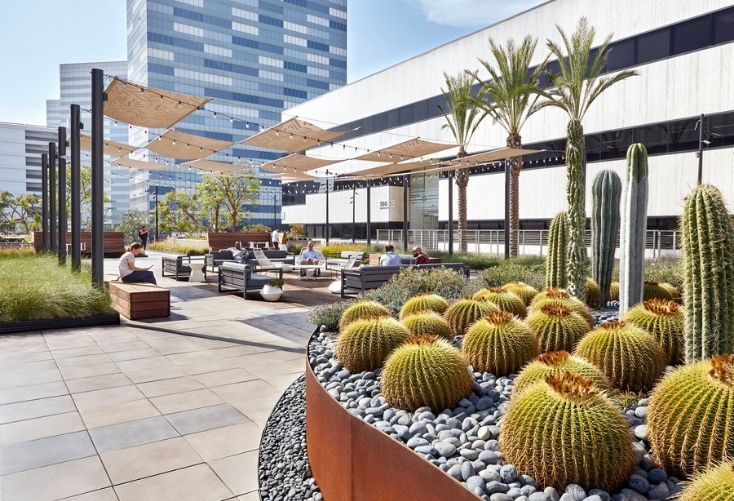
Kate Wieczorek: On average, we spend 90% of our time indoors, but this metric reflects a time pre-COVID. Now we have experienced stay-at-home orders and social distancing measures, necessitating the need for many companies and businesses to close down their indoor spaces. Globally, we have had to stay in our homes more to reduce the spread of the disease. Thus, it can be accepted that this percentage of time spent indoors has increased, especially in dense cities that may not have the luxury of private outdoor spaces.
We have all seen offices equipped with green walls, outdoor terraces, and other spatial elements mimicking our natural world. Biophilic design, or enhancing the human-nature connection within the built environment, has roots embedded throughout history. It was popularized as a concept in 1984, and became a workplace trend in the 2010s. However, biophilic design was seen in the past as a “nice to have” versus necessary, and on various projects seeking additional cost savings – green walls would be part of the first elements to be “value-engineered”, i.e. taken out of the scope.
As human beings, we inherently seek to feel connected to nature. Scientific research and theories demonstrate that we have an intrinsic need for exposure to natural environments. We experience benefits in this such as increasing productivity, improving physical health, and promoting mental well-being. In taking a holistic approach to our well-being, we need to create the impetus for us to be outdoors and feel connected with nature.
Considering the future of workplace design, biophilia and other elements of nature will be more embedded as the focus will shift more on creating safe and healthy environments. This includes not only aesthetics but also air quality, access to wellness spaces, and other indirect nature components.
Allwork.Space: With wellness and safe social interaction a key priority for workers and organizations alike, workplace design trends are shifting from the built environment to the outdoors. What are some of the challenges associated with creating and building an office outdoors?
Allison Zofan: Outdoor offices are great if you live in a place like San Diego where inclement weather is hardly ever an issue. Given this and different employee preferences – including personal comfort and allergies – providing access to the outdoors with the comforts of the indoors will be the only sustainable option for the majority of employers. Ideally, this will be a mix of outdoor seating with close-by, conditioned quiet space when nature doesn’t cooperate with one’s desire to be outside. To be sure, some kind of outdoor space investment is a smart-one for post-pandemic workplace experience.
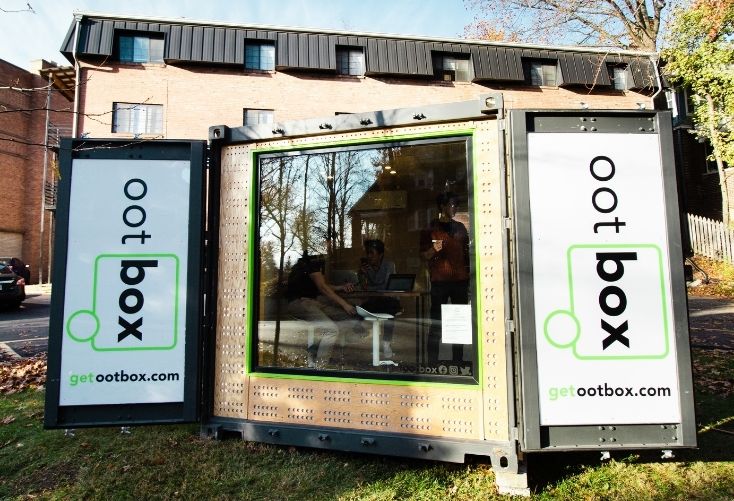
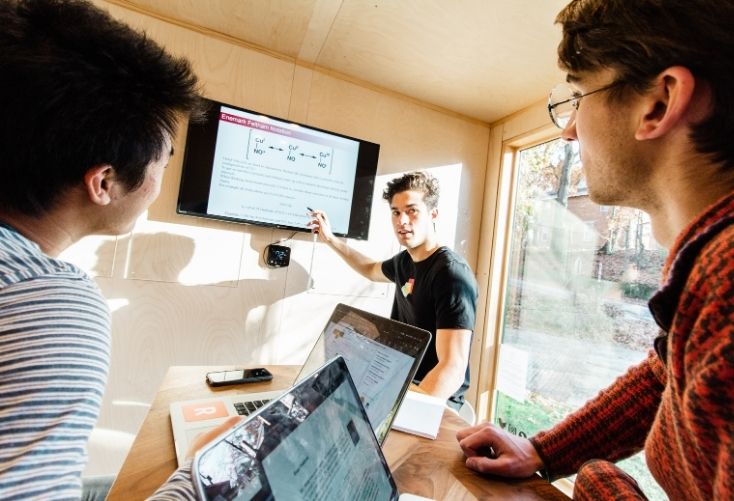
Kate Wieczorek: Weather could certainly be a deterrent of this trend. Places with colder climates would have shorter periods of comfortable outdoor access, while hotter climates would need cooling elements for a period of year. Supplemental heating and cooling would have been an integral part of the design. Opportunities for new technology in temperature control could emerge in order to support outdoor working.
If it is raining or storming – what do you do? Do employees work from home that day? Does your space reservation system check the weather and provide ideal climate days for an important meeting? Is there a retractable roof and side panels that automatically deploy the moment a raindrop hits or if the wind speed goes above a certain threshold? Do you keep a portion of your workplace fully enclosed with retractable glass walls? These all have to be considered in the outdoor workplace strategy.
Acoustics will be a factor in designing outdoor offices. Planes flying overhead, wind, and construction noise in cities could interfere with meetings. Though for some individuals, these sounds could be the perfect white noise background for completing their heads-down focus tasks.
This is all to say – unique challenges certainly exist for this trend. However, through creative problem solving we can approach these downsides as opportunities to develop new technology. The upsides to working outside swing in favor of cultivating happier, healthier, and more productive employees.
Paolo Trevisan: The pandemic has accelerated the change of many things, but it has not disrupted our human need to interact and socialize. Outdoor workspaces could provide a unique opportunity for workers to once again come together to collaborate and solve problems. The environment where we work can influence behavior. It also encourages natural interaction and socialization. The key to designing an outdoor workspace is to always consider the human experience first. Providing adequate shade and integrating seamless Wi-Fi connectivity are some of the essential elements to incorporate within the design of outdoor office spaces. Modular furniture with easily cleanable materials is also key as this will offer flexibility to the use of the space. Our team at Pininfarina is currently working on an exclusive office building where we’ve included large balconies for the office to use as open work spaces.
Jairo Vives: Some of the most challenging aspects of outdoor office space is mitigating the exposure to the natural elements. While this type of solution is becoming an interesting trend, we often challenge the role of the environment of a building to provide comfortable places. We do this by blurring the boundary of indoor and outdoor space and by implementing passive strategies. The goal is to provide comfortable areas so that people can socialize, share, and collaborate. Another consideration is materiality: what fabrics are comfortable for employees, easy to clean, but also durable, given that your selections will be exposed to the elements? We’ve seen an increased demand for antimicrobial fabrics — which are most often used within healthcare settings. Some of the most common antimicrobial fabrics are polyester and vinyl; polyester can actually work well outside if chosen carefully.
Louise Sharp: Some of the challenges in creating outdoor workspaces include shading, wind protection, climate control, and access to technology while working outdoors.
Human Comfort Models can be created to help determine the best means of designing spaces based on local conditions, and landscaping can be designed to manage some of the environmental challenges. Access to technology can be more of a challenge because it requires infrastructure that is traditionally stored indoors and has been designed to serve specific building zones. Diverse types of meeting settings can be explored to better suit outdoor work in the same way breakout spaces and conference rooms have evolved for interior settings.
For example, an outdoor work space could provide informal group settings without a screen, partial indoor/outdoor spaces that include more technology, flexible solutions such as pavilions or roll away screens, and permanently built pavilions within a larger outdoor setting – like a greenhouse space within a garden.
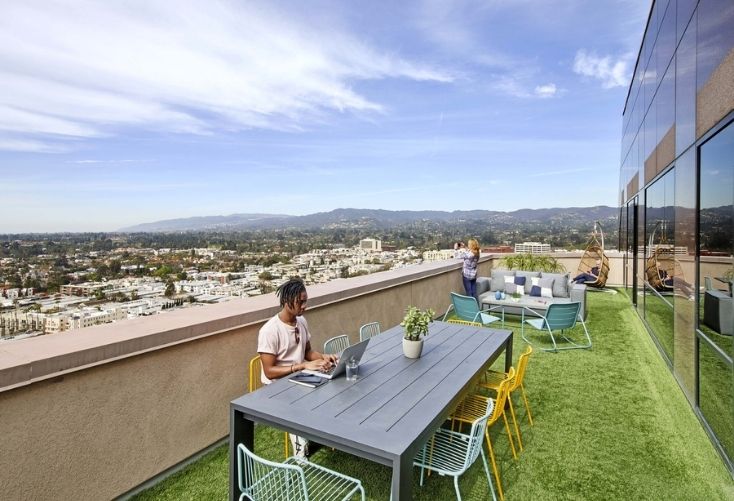
Allwork.Space: In some cases, creating outdoor offices might not be feasible for various reasons. For organizations that are not able to do so, what are some ways they can embrace the outdoors in their existing spaces?
Allison Zofan: Now that everyone has had to think creatively about where to work while at home, harnessing that creativity in return to work plans will be important. We know people can work in “non-traditional” settings so explore them and teach employees how to use that creativity at the office too. What comes to mind for me is hybrid spaces – think open-air cafés, outdoor seating, or athletic fields on a corporate campus. They’re smart investments during a pandemic, but also for long-term employee health and preventing burnout. ootBox is a great way for organizations to embrace the outdoors without huge capital or land investments because they are leasable and compatible with any outdoor setting.
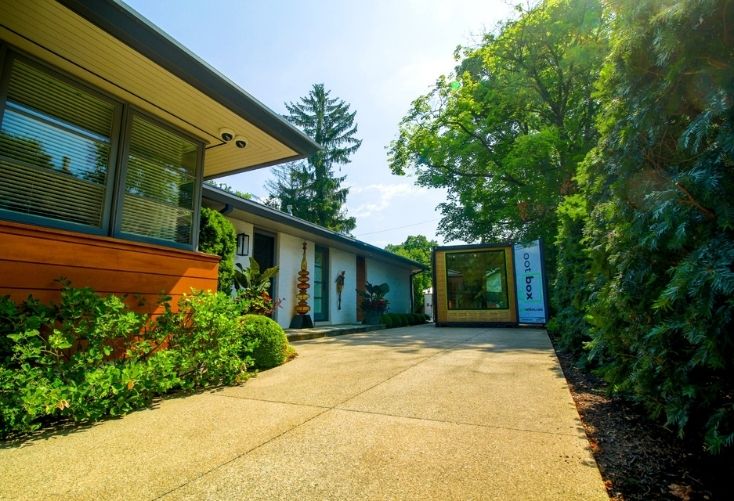
Paolo Trevisan: Biophilic design has been an area of focus for workplace design for many years, however, the pandemic has only enhanced the importance because we anticipate that workers will be concerned with air quality. The ideal solution would be to offer open-air balconies or sundecks extending from interior workspace, but there are other ways to adapt existing spaces without altering a building’s infrastructure as significantly. We envision a greater emphasis on this within commercial real estate in the future, rooting both design and infrastructure in nature-based elements. We also envision spaces becoming more versatile, functional, modular, and adaptable.
Jairo Vives: There are multiple ways in which organizations can embrace the outdoors, such as using natural elements and materials as active design elements, promoting outdoor experiences indoors, promoting physical movement, improving indoor air quality, and quality of natural light. Biophilia is an innate tendency to seek connections with nature so when we talk about biophilic design, we’re typically referring to design features that reconnect people with nature.
There are numerous small things we can incorporate into workplace design that bring us a step closer to the original state we were meant to be in. For example, indoor air quality is measured in the purity of the air we inhale, therefore there are some standards already established by EPA and enforced by local and international building codes. As it turns out, air-conditioned spaces have an acceptable level but one that is not optimal for our wellbeing. Optimal is fresh natural air, free of pollution. We can achieve this by filtering natural air through plants, such as English Ivy, Aloe Vera, and Chrysanthemums. There are also many versatile air purifier systems on the market, ranging from desktop fans to state-of-the-art advanced machine
Kate Wieczorek: Organizations have already been deploying outdoor terraces and parks as an amenity to its employees. Below demonstrates imagery and examples of company outdoor terraces in NYC.
Organizations within suburban office parks can also investigate the feasibility of creating patio or outdoor spaces nearby. Perhaps the landlord or complex will look into converting a portion of green space or the parking lot into an outdoor space to attract tenants.
When considering an outdoor element, re-designing furniture to blend within the natural environment should also be considered as well. The model of the outdoor workplace should incorporate both flexibility and durability – as is the case with any workplace model today.
If companies do not have access or the ability to build out their current office space onto outdoor terraces, they can incorporate more plants within the space or create an interior conservatory or greenhouse. From a programming perspective, requiring no physical changes to the office, companies can hold outdoor town halls or events at nearby parks. Leaders can be encouraged to leave the office and hold walking meetings or outdoor meetings. If employees are working from home and have access to outdoor space, they can be encouraged to hold their zoom calls outside rather than inside their homes.
Louise Sharp:
- Spaces must allow access to views and daylight for all. When designing a new space, designers must give consideration to where spaces are located to allow for this. This could involve making physical changes to the infrastructure by adding skylights, solar tubes, or other means of introducing daylight into less traditional building types like warehouses.
i. Specific project examples of this would be:- Procore – solar tubes were added at the roof and increased glazing at the exterior created greater transparency between indoor/outdoor.
- Deutsch/Steelhead – introducing larger top lit openings above the interior balcony.
- Workspaces must be less of a sealed container and more of a flexible space that offers different means of connecting the indoor/outdoor spaces.
- Utilizing existing conditions with smaller outdoor space such as balconies or interior atrium spaces.
- Landlords can incorporate more outdoor space for tenant use within buildings such as roof tops, balconies, or other shared common spaces. For example, Campus 2100 previously had a fully enclosed ground level courtyard and LA 915 Wilshire’s upper level space, which both now serve as tenant amenity spaces for the entire building.
- Incorporating biophilic design ideas within interior spaces through plants and natural materials as well as shapes and forms that mimic natural elements.
- Windows or openings should be operable to allow the users to have greater control over their environment.
- Flexibility is very important. When designing, spaces need to consider how things will change. This can include climate, workplace culture, organizational structure, or other outside influences.
Allwork.Space: What are some of the benefits of creating a complete outdoor work experience?
Allison Zofan: The winner here is employee choice: providing the option for employees to work outdoors or to move between an indoor and outdoor experience. Providing this benefit will differentiate you from other employers and create a truly unique work experience. ootBox is unlike the features you see in most workplaces and is a great place to begin or at least experiment with an outdoor work experience.
Kate Wieczorek: A completely outdoor experience has a good amount of benefits, several are listed below:
- Promotes health, happiness, and engagement of employees from realizing the benefits of being outside
- Serves as a tool for attracting publicity or top talent, as having a completely outdoor work experience will be unique in the field of workplace design
- Providing a completely unique experience that could spark more innovative ideas
- Provide a relaxing area to decompress from job or life stress
- Promote a feeling of safety and hospitality, as having outdoor access is a component of most homes in suburbia
- Demonstrate that the organization truly cares about its employees well being
Paolo Trevisan: The benefits of biophilic design in the workplace are well documented in terms of productivity, but as we see an increased focus on health and wellbeing in all aspects of our lives, biophilic design can be used as a tool for companies to make employees happy. We believe that the office should strike a comfortable balance between indoor and outdoor spaces. Not everyone will want to work outside and vice versa, but the benefits of biophilia, natural lighting, and air quality are essential elements for employees. As a result, the indoor space should reflect the same level of health and wellness as the outdoor spaces. The two spaces should seamlessly blend together and create a balance.
Louise Sharp: Office space has often been shaped from the inside out but perhaps now is the time to think outside in. What if a workspace was a series of pavilions (fully built out or partially enclosed) within a larger outdoor environment with interstitial spaces in between for individual work. We have seen pavilions or greenhouse type spaces used for dining (such as the Line Hotel Commissary) and with smaller residential projects that have separate sleep and social pavilions, so why not for a meeting or work space? Now is the time to push the boundaries of what we think an office space can be. While a full outdoor work experience could pose challenges with weather and technology infrastructure, giving employees the flexibility to work outside whenever they please and providing the same diversity of settings that an indoor environment can offer, and being able to do it with ease, can only benefit the worker and the working environment.
Working outdoors should be encouraged. Employees have demonstrated they can be autonomous in completing their tasks, and do not need to physically be in their work seat in the office in order to get their job done. Access to nature can spark creativity, provide tranquility, and increase energy. Individuals working from home with access to private spaces have already implemented working outside in their daily routine. Organizations seeking to rethink their workplaces would be wise to consider providing a variety of outdoor office space for employees.


Love the idea of an outdoor office space. If done right, it can be a great addition to any work place.